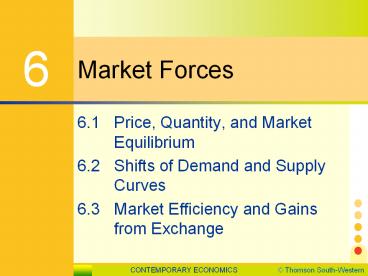Market Forces - PowerPoint PPT Presentation
1 / 13
Title:
Market Forces
Description:
Market Forces 6 6.1 Price, Quantity, and Market Equilibrium 6.2 Shifts of Demand and Supply Curves 6.3 Market Efficiency and Gains from Exchange 6.1 Price, Quantity ... – PowerPoint PPT presentation
Number of Views:138
Avg rating:3.0/5.0
Title: Market Forces
1
Market Forces
6
- 6.1 Price, Quantity, and Market Equilibrium
- 6.2 Shifts of Demand and Supply Curves
- 6.3 Market Efficiency and Gains from Exchange
2
CONSIDER
- How is market competition different from
competition in sports and in games? - Why do car dealers usually locate together on the
outskirts of town? - Whats the difference between making stuff right
and making the right stuff? - Why do government efforts to keep rents low
usually lead to a housing shortage? - Why do consumers benefit nearly as much from a
low price as from a zero price?
3
6.1 Price, Quantity, andMarket Equilibrium
Objectives
- Understand how markets reach equilibrium.
- Explain how markets reduce transaction costs.
4
6.1 Price, Quantity, andMarket Equilibrium
Key Terms
- market equilibrium
- surplus
- shortage
- transaction cost
5
Market Equilibrium
- When the quantity that consumers are willing and
able to buy equals the quantity that producers
are willing and able to sell, that market reaches
market equilibrium.
6
Equilibrium in the Pizza Market
Figure 6.1
7
Surplus Forces the Price Down
- At a given price, the amount by which quantity
supplied exceeds quantity demanded is called the
surplus. - As long as quantity supplied exceeds quantity
demanded, the surplus forces the price lower.
8
Shortage Forces the Price Up
- At a given price, the amount by which quantity
demanded exceeds quantity supplied is called the
shortage. - As long as quantity demanded and quantity
supplied differ, this difference forces a price
change.
9
Market Forces Lead toEquilibrium Price and
Quantity
- The equilibrium price, or market-clearing price,
equates quantity demanded with quantity supplied. - Because there is no shortage and no surplus,
there is no longer any pressure for the price to
change.
10
Market Exchange
- Markets answer the questions
- What to produce
- How to produce it
- For whom to produce it
11
Adam Smiths Invisible Hand
- Although each individual pursues his or her own
self-interest, the invisible hand of market
competition promotes the general welfare.
12
Market Exchange Is Voluntary
- Neither buyers nor sellers would participate in
the market unless they expected to be better off. - Prices help people recognize market opportunities
to make better choices as consumers and as
producers.
13
Markets Reduce Transaction Costs
- Transaction costs are the cost of time and
information needed to carry out market exchange. - The higher the transaction cost, the less likely
the exchange will take place.

